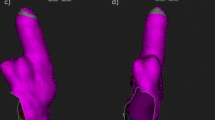Abstract
The aim of this study is to evaluate the feasibility of creating fast three-dimensional maps of coronary arteries and to develop a bipolar coronary guidewire in vitro and determine whether it can be localised accurately within the model.
A total of five patients were recruited, and EnSite Precision was utilised to create 3D coronary anatomy. A water bath to accommodate a 3D-printed coronary model was developed to test the performance of the bipolar angioplasty wire.
Successful guidewire localisation and 3D reconstruction of coronary anatomy were achieved in all the cases. No complications. The bipolar wire was able to collect point clouds, and localisation of the distal tip was excellent when tested in the water bath.
Our study demonstrates the feasibility and safety of utilising EAMS to collect coronary anatomy. Real-time tracking with a bipolar catheter is accurate when tested in vitro.




Similar content being viewed by others
References
Cousins C, et al. ICRP PUBLICATION 120: Radiological protection in cardiology. Ann ICRP. 2013;42:1–125.
Ciraj-Bjelac O, et al. Risk for radiation-induced cataract for staff in interventional cardiology: is there reason for concern? Catheter Cardiovasc Interv. 2010;76:826–34.
Persson PB. Contrast-induced nephropathy. Eur Radiol. 2005;15(Suppl 4):D65–9.
Knackstedt C, et al. Electro-anatomic mapping systems in arrhythmias. Europace. 2008;10(Suppl 3):iii28-34.
Matsubara TJ, et al. Fluoroless and contrast-free catheter ablation without a lead apron in routine clinical practice. Sci Rep. 2020;10:17096.
Del Greco M, et al. Three-dimensional electroanatomic mapping system-enhanced cardiac resynchronization therapy device implantation: results from a multicenter registry. J Cardiovasc Electrophysiol. 2017;28:85–93.
Tovia-Brodie O, et al. Use of new imaging CARTO® segmentation module software to facilitate ablation of ventricular arrhythmias. J Cardiovasc Electrophysiol. 2017;28:240–8.
Nair M, et al. First in man: percutaneous coronary angioplasty using non-fluoroscopic electro-anatomic mapping. Int J Cardiovasc Imaging. 2020;36:1189–90.
Dorval J, et al. Electroanatomical navigation to minimize contrast medium or X-rays during stenting. J Am Coll Cardiol Basic Trans Sci. 2022;7:131–42.
O’Neill J, Hogarth AJ, Pearson I, Law H, Bowes R, Kidambi A, Wheatcroft S, Sivananthan UM, Tayebjee MH. Transcoronary pacing to assess myocardial viability prior to percutaneous coronary intervention: pilot study to assess feasibility. Catheter Cardiovasc Interv. 2018;92:269–73.
Tuzcu V. A nonfluoroscopic approach for electrophysiology and catheter ablation procedures using a three-dimensional navigation system. Pacing Clin Electrophysiol. 2007;30:519–25.
Acknowledgements
We would like to thank Abbott Medical (UK) for providing technical support.
Funding
This study was funded by Abbott Medical.
Author information
Authors and Affiliations
Corresponding author
Ethics declarations
Conflict of Interest
Rabeia Javid is an Abbott electrophysiology fellow. Dr. Muzahir Tayebjee has received research/travel grants from Abbott Medical, Biosense Webster, Medtronic, and Boehringer Ingelheim. Professor Wheatcroft has received funding from the British Heart Foundation, Medical Research Council, and the European Research Council. Amr Abdelrahman has no conflicts of interest to declare. Abdul Mozid has no conflict of interest to declare. Sapna Puppla has no conflict of interest to declare. Robert Thompson has no conflict of interest to declare.
Additional information
Associate Editor Craig M. Stolen oversaw the review of this article
Publisher’s Note
Springer Nature remains neutral with regard to jurisdictional claims in published maps and institutional affiliations.
Rights and permissions
About this article
Cite this article
Javid, R., Abdelrahman, A., Thompson, R. et al. Imaging Real-Time Coronary Anatomy Using a Three-Dimensional Electrophysiology Mapping System. J. of Cardiovasc. Trans. Res. 16, 715–721 (2023). https://doi.org/10.1007/s12265-022-10341-x
Received:
Accepted:
Published:
Issue Date:
DOI: https://doi.org/10.1007/s12265-022-10341-x




